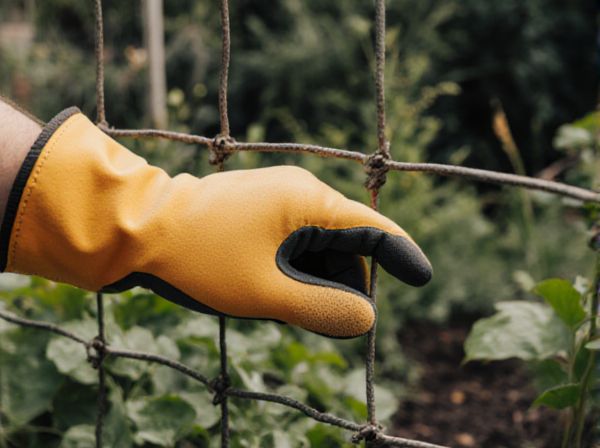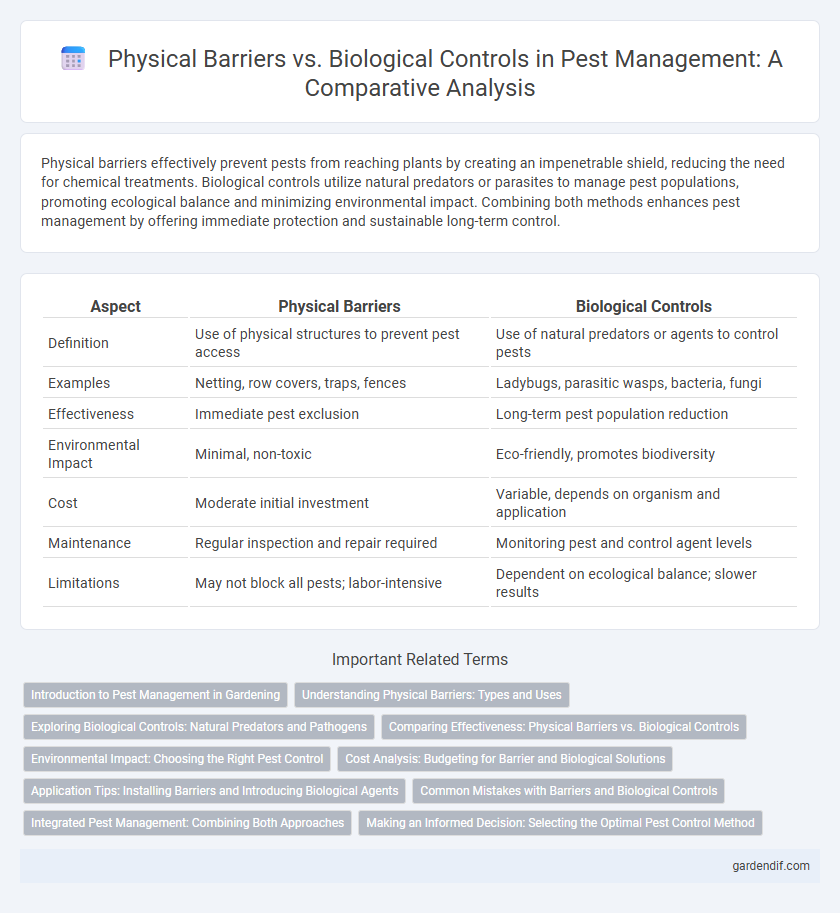
Physical barriers vs biological controls Illustration
Physical barriers effectively prevent pests from reaching plants by creating an impenetrable shield, reducing the need for chemical treatments. Biological controls utilize natural predators or parasites to manage pest populations, promoting ecological balance and minimizing environmental impact. Combining both methods enhances pest management by offering immediate protection and sustainable long-term control.
Table of Comparison
| Aspect | Physical Barriers | Biological Controls |
|---|---|---|
| Definition | Use of physical structures to prevent pest access | Use of natural predators or agents to control pests |
| Examples | Netting, row covers, traps, fences | Ladybugs, parasitic wasps, bacteria, fungi |
| Effectiveness | Immediate pest exclusion | Long-term pest population reduction |
| Environmental Impact | Minimal, non-toxic | Eco-friendly, promotes biodiversity |
| Cost | Moderate initial investment | Variable, depends on organism and application |
| Maintenance | Regular inspection and repair required | Monitoring pest and control agent levels |
| Limitations | May not block all pests; labor-intensive | Dependent on ecological balance; slower results |
Introduction to Pest Management in Gardening
Physical barriers in pest management include tools like row covers, nets, and collars that prevent pests from reaching plants, effectively reducing infestations without chemicals. Biological controls involve using natural predators, parasites, or pathogens such as ladybugs, nematodes, and Bacillus thuringiensis to suppress pest populations sustainably. Integrating these methods enhances pest management in gardening by minimizing environmental impact while protecting plant health.
Understanding Physical Barriers: Types and Uses
Physical barriers in pest management include materials like nets, row covers, and collars that prevent pest access to crops by creating a direct obstruction. These barriers are effective against insects, birds, and larger animals by blocking entry points without the use of chemicals. Selecting appropriate physical barriers depends on the target pest species, crop type, and environmental conditions to maximize pest exclusion and protect plant health.
Exploring Biological Controls: Natural Predators and Pathogens
Biological controls leverage natural predators and pathogens to manage pest populations effectively, reducing reliance on chemical pesticides. Predatory insects like ladybugs and parasitic wasps target specific pests, while entomopathogenic fungi and bacteria cause diseases in harmful insect species. These natural agents maintain ecological balance and promote sustainable pest management by minimizing environmental impact and enhancing crop health.
Comparing Effectiveness: Physical Barriers vs. Biological Controls
Physical barriers such as nets, row covers, and fences provide immediate and direct protection against pests by preventing access to plants, proving highly effective in managing insect and bird infestations without chemical use. Biological controls utilize natural predators, parasites, or pathogens to suppress pest populations, offering sustainable and ecologically balanced pest management but often requiring longer periods to establish effectiveness. Comparing both methods, physical barriers deliver rapid and consistent protection with minimal ecological impact, while biological controls enhance long-term pest regulation and biodiversity, making integrated use ideal for comprehensive pest management.
Environmental Impact: Choosing the Right Pest Control
Physical barriers such as nets, screens, and collars prevent pest access without introducing harmful substances, minimizing negative environmental impacts. Biological controls use natural predators or pathogens to target pests, promoting ecological balance but requiring careful management to avoid unintended effects on non-target species. Selecting pest control methods based on environmental impact helps maintain biodiversity and reduces chemical residues in soil and water.
Cost Analysis: Budgeting for Barrier and Biological Solutions
Physical barriers like nets and fences typically require higher initial investment and periodic maintenance costs but offer immediate and visible protection against pests. Biological controls, involving predators or pathogens, demand ongoing monitoring and potential reapplication expenses but often reduce long-term reliance on chemical treatments. Budget planning should consider upfront installation versus sustainability costs, aligning with crop type and pest pressure to optimize resource allocation.
Application Tips: Installing Barriers and Introducing Biological Agents
Installing physical barriers such as row covers, screens, or collars effectively prevents pest access to plants by creating a direct obstacle. Introducing biological agents like ladybugs, predatory mites, or parasitic wasps requires monitoring environmental conditions to ensure their survival and efficacy. Proper timing, placement, and maintenance of both barriers and biocontrol organisms optimize pest management outcomes in agricultural and garden settings.
Common Mistakes with Barriers and Biological Controls
Common mistakes with physical barriers include incorrect installation that allows pests to bypass them, such as gaps under doors or improperly sealed edges. Biological controls often fail due to the introduction of non-native species without thorough ecological assessment, leading to unintended impacts on local ecosystems. Neglecting regular monitoring and adjustment of both barriers and biological agents reduces their effectiveness against pest populations.
Integrated Pest Management: Combining Both Approaches
Integrated Pest Management (IPM) leverages physical barriers such as nets, traps, and mulches alongside biological controls including beneficial predators and pathogens to effectively reduce pest populations. Combining these strategies minimizes chemical pesticide use, promoting environmental sustainability and long-term pest suppression. Data from agricultural studies show that IPM approaches combining physical and biological methods can decrease pest damage by up to 70% while enhancing crop yield quality.
Making an Informed Decision: Selecting the Optimal Pest Control Method
Evaluating physical barriers and biological controls requires considering factors such as pest species, environment, and long-term effectiveness to select the most suitable pest control method. Physical barriers offer immediate, chemical-free protection by blocking pest entry, while biological controls leverage natural predators to manage pest populations sustainably. Balancing cost, impact on non-target species, and ecological compatibility is essential for making an informed pest management decision.
Physical barriers vs biological controls Infographic

 gardendif.com
gardendif.com